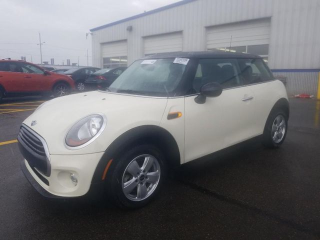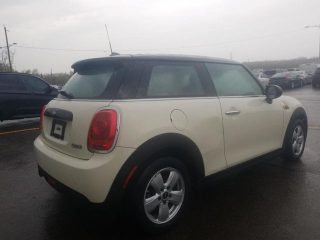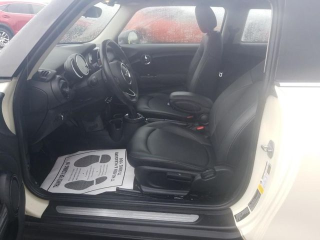The Good
The 2016 Mini Cooper offers a blend of advantages appealing to both heart and mind. Its "go-kart" handling and spirited engine options (especially Cooper S and JCW) deliver an exhilarating driving experience. The iconic, customizable design and premium interior exude character. Practical benefits include commendable fuel efficiency, a surprisingly comfortable ride for its size, and compact dimensions for city maneuverability. It provides a unique, fun-to-drive personality alongside a respectable blend of style, performance, and everyday usability.
The Bad
While charming, the 2016 Mini Cooper has some known weaknesses. Rear passenger and cargo space in the 2-door hatchback are notably limited. The ride, though improved from earlier generations, can still feel firm to some, especially with larger wheels and run-flat tires. Owners should be prepared for potentially higher maintenance and repair costs compared to some non-premium rivals. Some electrical gremlins and oil leak concerns have been reported across the brand, warranting thorough pre-purchase inspection.
2016 Mini Cooper: Quick Overview
The 2016 Mini Cooper offers a range of engines and features across its trims:
- Engine Options:
- Cooper: 1.5-liter TwinPower Turbo 3-cylinder engine.
- Cooper S: 2.0-liter TwinPower Turbo 4-cylinder engine.
- John Cooper Works (JCW): A more potent version of the 2.0-liter TwinPower Turbo 4-cylinder engine.
- Horsepower:
- Cooper: 134 hp.
- Cooper S: 189 hp.
- JCW: 228 hp.
- Fuel Economy (Combined EPA estimates, varying by transmission and body style):
- Cooper: Approximately 30-32 MPG.
- Cooper S: Approximately 28-30 MPG.
- JCW: Approximately 28 MPG.
- 0-60 MPH Acceleration (approximate):
- Cooper: 7.3 - 7.6 seconds.
- Cooper S: 6.3 - 6.5 seconds.
- JCW: 5.9 - 6.1 seconds.
- Towing Capacity: The 2016 Mini Cooper is not typically rated or recommended for significant towing.
- Trim-Level Features:
- Cooper (Base): Standard features include the 1.5L 3-cylinder engine, a 6-speed manual transmission (6-speed automatic optional), 15-inch alloy wheels, automatic headlights and wipers, push-button start, simulated leather upholstery, and the MINI Connected infotainment system with a 6.5-inch display, Bluetooth connectivity, and a USB port.
- Cooper S: Builds upon the Cooper with the more powerful 2.0L 4-cylinder engine, sport seats, 16-inch alloy wheels, LED fog lights, and a distinctive center-mounted dual exhaust.
- John Cooper Works (JCW): The performance flagship, featuring the higher-output 2.0L engine, specific Brembo sport brakes, a sport-tuned suspension, an aerodynamic body kit, 17-inch JCW alloy wheels, exclusive JCW sport seats, and unique interior trim.
- Optional Features & Packages (available across trims): Mini is renowned for its customization. Key options include the Premium Package (panoramic sunroof, Harman Kardon premium sound system), Cold Weather Package (heated front seats, power-folding mirrors), Sport Package (dynamic damper control, larger wheels, LED headlights), Media Package (8.8-inch display with navigation, enhanced Bluetooth, smartphone integration), and the Driver Assistance Package (rearview camera, parking sensors, head-up display). Extensive individual options also allowed for personalization of exterior color, roof color, stripes, interior surfaces, and more.
2016 Mini Cooper Specifications
Vehicle Information
| Year | 2016 |
| Make | Mini |
| Model | Cooper |
| Trim | - |
| Style | 4-Door Hatchback Front-Wheel Drive |
| Type | Hatchback |
| Category | Subcompact Car |
Manufacturing Details
| Made In | United Kingdom |
| Manufacturing City | BOM |
Dimensions
| Doors | 4-Door |
| Curb Weight | 1190.68 kg |
| Gross Vehicle Weight Rating | 1669.22 kg |
| Overall Height | 141.48 cm |
| Overall Length | 383.79 cm |
| Overall Width | 172.72 cm |
| Wheelbase Length | 249.43 cm |
| Standard Seating | 4 |
Engine & Performance
| Engine | 1.5-L I3 |
| Engine Size | 1.5L |
| Engine Cylinders | 3 |
| Transmission | 6-Speed Automatic |
| Transmission Type | Automatic |
| Transmission Speeds | 6-Speed |
| Drivetrain | Front-Wheel Drive |
Additional Features
| Anti-Brake System | 4-Wheel ABS |
| Steering Type | Rack & Pinion |
Pricing
| Manufacturer Suggested Retail Price (MSRP) | $20,700 USD |
| Invoice Price | $19,660 USD |
| Delivery Charges | $850 USD |
Vehicle History Report
Specifications
History
Events
History Check
Check
Check
Check
Check
Listings
Recalls
Check
Analysis
What Problems Does the 2016 Mini Cooper Have?
While the 2016 Mini Cooper (F55/F56 generation) generally improved upon its predecessors' reliability, certain issues are still frequently reported and worth noting for long-term ownership.
- Oil Leaks: Common across many BMW-engined vehicles, including Minis. Owners frequently report leaks from the valve cover gasket, oil filter housing gasket, and oil pan gasket. These should be addressed promptly to prevent more significant engine damage.
- Coolant Leaks: The plastic components of the cooling system, such as the thermostat housing and water pump, can be prone to cracking and leaking over time. Regular inspection of coolant levels and visual checks for leaks are advisable.
- Electrical Gremlins: Mini vehicles can occasionally suffer from various electrical issues, ranging from sensor malfunctions to infotainment glitches or problems with power windows and locks. While not always critical, they can be frustrating.
- Engine Mounts: Especially in the sportier Cooper S and JCW models, engine mounts can wear out prematurely due to the stiffer suspension and enthusiastic driving, leading to increased vibration and noise.
- Carbon Buildup: As with many direct-injection engines, carbon buildup on the intake valves can occur over time, potentially leading to reduced performance and misfires. Regular "walnut blasting" may be required, though this issue was more prevalent in earlier generations and somewhat mitigated by design changes in the B-series engines.
- A/C System: Some owners have reported issues with the air conditioning system, including condenser leaks or compressor failures, leading to a loss of cooling.
Recalls: Several recalls affected the 2016 Mini Cooper. One significant recall (NHTSA Campaign Number 16V-463) concerned the passenger seat occupant detection mat, which could fail and prevent the front passenger airbag from deploying in a crash, increasing injury risk. Another recall (NHTSA Campaign Number 18V-395) addressed a potential short circuit in the wiring harness for the front passenger door, which could lead to overheating and, in rare cases, a fire. Prospective buyers should verify that all open recalls have been addressed by a Mini dealership.
How long will the 2016 Mini Cooper last?
What Technology & Safety Features are Included?
The 2016 Mini Cooper, reflecting its premium segment aspirations, came equipped with a solid array of built-in tech, entertainment, and safety features, with numerous optional upgrades enhancing its appeal.
- Infotainment & Entertainment:
- Standard: The base model includes the MINI Connected infotainment system with a 6.5-inch high-resolution display, Bluetooth phone and audio connectivity, a USB port, auxiliary audio input, and a six-speaker sound system. Push-button start is also standard.
- Optional: Upgrades include an 8.8-inch widescreen display, a navigation system, enhanced Bluetooth with audio streaming, a 12-speaker Harman Kardon premium audio system, satellite radio, and integration of various MINI-specific apps through a connected smartphone. A unique feature available was the head-up display, projecting key driving information onto a small screen in the driver's line of sight.
- Driver-Assistance Features:
- Optional: Available in various packages, these included a rearview camera, front and rear parking sensors, an automated parallel parking assist system, adaptive cruise control, and a forward collision warning system with automatic emergency braking, contributing to enhanced safety and convenience.
- Safety Features:
- Standard: All 2016 Mini Cooper models come with a comprehensive suite of safety equipment, including eight airbags (front, front side, side curtain, and front knee airbags), antilock disc brakes (ABS), stability control, traction control, and a tire pressure monitoring system. Run-flat tires were also standard, providing limited mobility after a puncture.
- Crash-Test Ratings:
- IIHS (Insurance Institute for Highway Safety): The 2016 Mini Cooper (2-door hatchback F56) performed well, earning a "Good" rating in moderate overlap front, side, roof strength, and head restraints & seats tests. It received an "Acceptable" rating in the small overlap front – driver-side test. When equipped with the optional forward collision warning and automatic braking, it earned a "Basic" rating for front crash prevention.
- NHTSA (National Highway Traffic Safety Administration): The 2016 Mini Cooper (2-door F56) received an overall safety rating of 4 out of 5 stars. It earned 4 stars for frontal crash, 5 stars for side crash, and 4 stars for rollover resistance.
What Colors Options are Available?
2016 Mini Cooper Prices and Market Value
In the current used market (2024), a 2016 Mini Cooper (depending on trim, condition, and mileage) can typically be found ranging from $9,000-$14,000 for a Cooper, $11,000-$17,000 for a Cooper S, and $15,000-$22,000 for a JCW.
Depreciation for the Mini Cooper is significant in the initial years but tends to stabilize somewhat thereafter. Factors greatly affecting its resale value include the specific trim level (S and JCW models hold value better), overall condition, complete service records demonstrating diligent maintenance, mileage, and the presence of desirable optional packages like navigation or premium audio. The unique character and niche appeal help maintain a certain level of demand.
2016 Mini Cooper Cost of Ownership
2016 Mini Cooper Fuel Efficiency
2016 Mini Cooper Safety Rating
IIHS
2016 Mini Cooper Warranty
Basic
Powertrain
Rust
2016 Mini Cooper Insurance
reasonable repair costs.
How Does the 2016 Mini Cooper Compare to Other Hatchback?
The 2016 Mini Cooper occupies a unique niche, blending premium style with spirited performance. When stacked against key rivals, its strengths and weaknesses become clearer:
- Versus Volkswagen GTI: The GTI is arguably the Mini Cooper S's most direct rival. The Mini offers a more distinctive, retro-chic design and a slightly more engaging "go-kart" feel. The GTI, however, often provides more practical space, a more refined ride, and a more potent base engine, alongside a reputation for strong reliability. For those prioritizing a balanced, understated performance hatchback, the GTI might be a "better" all-rounder.
- Versus Ford Fiesta ST: The Fiesta ST is a raw, unadulterated hot hatch. It's typically more affordable than the Mini Cooper S, offering exceptional handling and a thrilling driving experience. The Mini feels more premium inside and offers greater customization, but the Fiesta ST wins on sheer driving dynamics for the price, albeit with a less sophisticated interior.
- Versus Fiat 500 Abarth: Both are quirky, small, and characterful. The Abarth is louder and more aggressively styled, but the Mini Cooper offers significantly superior build quality, a more refined ride, and much better interior technology and comfort. The Abarth is a niche choice for pure exuberance, while the Mini is a more well-rounded premium subcompact.
- Versus Mazda 3: While not a direct hot hatch competitor to the Cooper S/JCW, the Mazda 3 offers exceptional driving dynamics for a non-performance compact, coupled with outstanding reliability and good fuel economy. It lacks the Mini's premium interior and iconic styling but delivers tremendous value and a more practical ownership experience.
Reliability & Price: In terms of long-term reliability, the Mini Cooper, while improved, often falls short of the Mazda 3 and Volkswagen Golf/GTI. Its premium pricing also means it's generally more expensive than a Fiesta ST or a well-equipped Mazda 3, sitting closer to the GTI or even an entry-level Audi A3.
Recommendations:
For more overall practicality, refinement, and potentially better long-term reliability, consider the Volkswagen GTI. For a pure, no-frills, affordable driving thrill, the Ford Fiesta ST is an excellent choice. If a premium feel with great driving dynamics and bulletproof reliability is paramount, the Mazda 3 is a compelling alternative, albeit less "fun" looking.
Final Verdict: Is the 2016 Mini Cooper a Good Hatchback?
It is absolutely worth buying, but under specific conditions. As a used vehicle, it offers significantly better value than new, having absorbed the initial depreciation hit. The Cooper S trim often presents the best balance of performance and cost for most buyers. The base Cooper is a stylish and efficient choice, while the JCW is for enthusiasts seeking maximum thrills and willing to accept higher running costs.
Prospective buyers must be prepared for potentially higher maintenance and repair expenses compared to non-premium rivals. A comprehensive pre-purchase inspection and a clear, documented service history are paramount. If these conditions are met, the 2016 Mini Cooper delivers an undeniably fun and characterful ownership experience.



